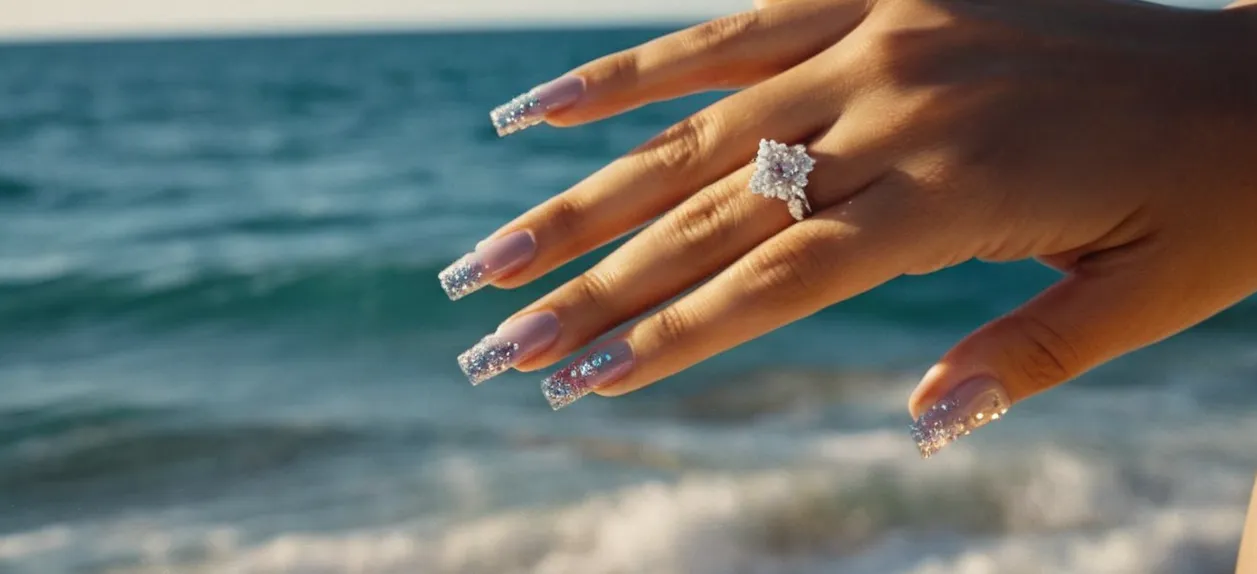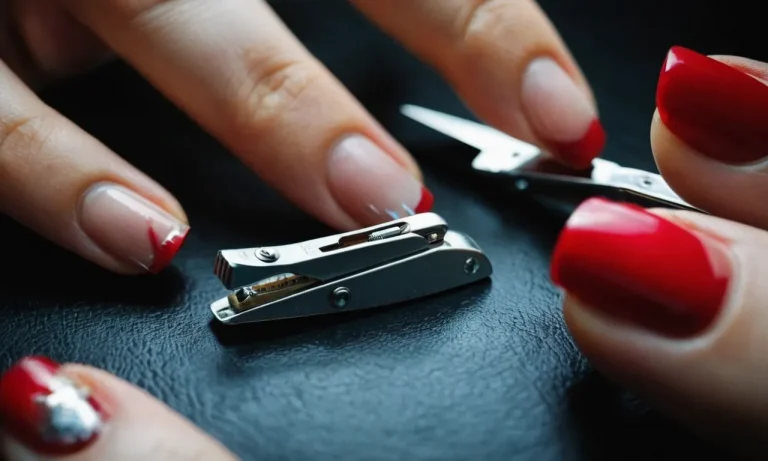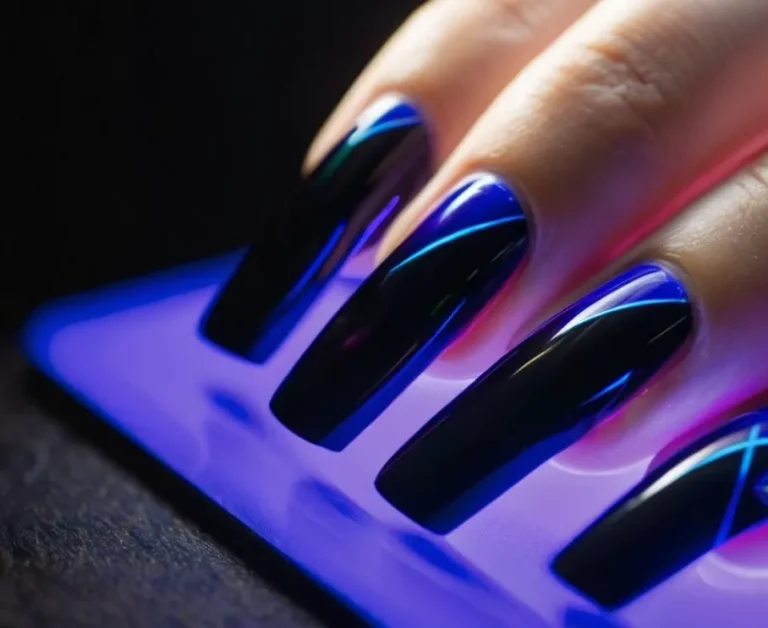Does Salt Water Ruin Acrylic Nails? A Detailed Guide
Swimming in the ocean or soaking in a saltwater pool can be relaxing, but is it damaging your beautiful acrylic nails? Acrylic nails and salt water don’t always mix well, but with some precautions you can enjoy the water without ruining your manicure.
If you’re short on time, here’s a quick answer: Salt water can damage acrylic nails, causing them to lift, soften, discolor, or develop cracks. However, there are steps you can take to protect acrylic nails in salt water, like applying nail wraps, using gel polish, getting professional tips, and moisturizing after swimming.
In this comprehensive guide, we’ll cover everything you need to know about the effects of salt water on acrylics and how to keep your nails looking fabulous at the beach or pool.
How Salt Water Affects Acrylic Nails
Softening and Lifting
Salt water can cause acrylic nails to soften and lift from the natural nail bed over time. The salt interacts with the polymers in the acrylic powder, breaking down the bonds that give acrylic its hard, durable properties.
As the acrylic softens, it can start to lift at the edges and peel away from the nail. This leaves gaps where bacteria and fungi can get in and cause infections.
To avoid softening and lifting, limit the amount of time your acrylic nails spend soaked in salt water. After swimming in the ocean or soaking in a salt bath, gently cleanse nails and apply cuticle oil to nourish the skin and acrylic.
Getting acrylic nails filled every 2-3 weeks will help prevent lifting by applying fresh acrylic as the old material thins.
Discoloration
The salt and minerals present in ocean water can lead to unsightly yellowing and discoloration of acrylic nails. As salt interacts with the acrylic polymers, it opens up micro-abrasions that allow dirt and grime to get trapped, causing a yellowish, dingy appearance.
To prevent discoloration, avoid wearing dark polish to the beach or pool, as this will show staining more readily. Rinse nails with fresh water after saltwater exposure and scrub gently with a nail brush. An occasional soak in diluted hydrogen peroxide can help lift stains from the acrylic surface.
Getting the nails buffed and polished every few weeks will remove layers of discolored acrylic.
Cracks and Splitting
The drying effects of salt can cause acrylic nails to become brittle and prone to cracking and splitting, especially at the free edges and side walls. As the nail plate expands and contracts with wet and dry conditions, the inflexible acrylic does not flex as easily, leading to stress fractures.
To avoid cracks, apply cuticle oil regularly when visiting the ocean to keep nails flexible. Avoid rough activity like opening soda cans or clamping shells that can stress the acrylic. Get small cracks repaired right away by having the nail rebonded or filled in, to prevent the split from worsening.
Keep nails filed and shaped properly so free edges are supported.
Tips to Protect Acrylic Nails in Salt Water
Apply Protective Nail Wraps
One great way to shield your acrylic nails from damage in salt water is to apply protective nail wraps or stickers. These act as a barrier between your nails and the water, preventing chips and cracks. Look for wraps made specifically for swimming that are waterproof.
Apply them neatly over each nail before getting in the ocean or pool.
Use Gel Polish
Gel polish forms a durable, protective layer over acrylic nails. The thick, gummy formula is resistant to chipping and peeling caused by water exposure. Paint your nails with two coats of a quality gel polish, then seal it with a gel top coat.
This creates a smooth, impervious shield over your manicure. Reapply the gel polish after swimming to keep your nails looking fab.
Get Professional Acrylic Application
Visiting a skilled nail technician for your acrylic application makes a big difference in how well they hold up in water. A pro will prep your nails properly, apply the right ratio of acrylic powder and liquid, and seal the edges to minimize lifting and cracking.
Quality salon acrylics are more durable than drugstore kits. Paying for pro manicures is worth it to keep your nails looking amazing on beach vacations.
Moisturize After Swimming
Frequently moisturizing your hands and nails after saltwater exposure helps prevent acrylic damage. Salt can dry out and weaken acrylics, causing breaks and loosening. After ocean swimming or soaking in a saltwater pool, gently pat your hands dry and massage in a rich moisturizer.
Shea butter, coconut oil, and cuticle creams hydrate nails and cuticles, combatting the drying effects of salt.
Avoid Long Soaks
While brief swims are fine, soaking acrylic nails in saltwater for extended periods can lead to trouble. The constant exposure to drying salt, waves, and friction against pool surfaces taxes acrylics. Try to limit your saltwater soak time to an hour or less when possible.
When done swimming, promptly wash your hands with fresh water and apply moisturizer. Avoiding lengthy saltwater soaking reduces the risk of damage to your manicure.
Caring for Acrylic Nails After Salt Water Exposure
Acrylic nails can become damaged after exposure to salt water, whether from swimming in the ocean or spending time in a saltwater pool. Thankfully, there are several things you can do to care for your acrylics and keep them looking great after salt water exposure:
Gently File Away Lifted Edges
After being in salt water, you may notice some lifting or peeling around the edges of your acrylic nails. Take a nail file and gently smooth down any rough edges or lifted corners. Don’t file too aggressively, as this can thin out the acrylic and weaken it.
Just lightly buff to make the surface smooth again.
Use Cuticle Oil and Nail Strengtheners
Rubbing cuticle oil around the base of your nails and applying a nail strengthener can help condition and protect acrylics after saltwater exposure. The oil moisturizes and prevents drying and cracking, while the strengthener helps harden the nails.
Some great nourishing oils are jojoba, vitamin E, and coconut. Nailtiques Formula 2 is an excellent salon-grade strengthener.
Get a Fill or Rebalance If Needed
If your nails are looking a little thin or ragged after swimming, go in for a fill or rebalance. This will reinforce the nail structure by adding new acrylic where it’s needed. Your nail tech can examine each nail and do any necessary repairs. A fill helps restore strength and thickness.
Doing this regularly anyway is key to keeping acrylics in good shape.
Avoid Excessive Buffing and Filing
It’s tempting to vigorously file and buff nails after salt water damage, but this can actually weaken the acrylic structure. Use a light touch when filing edges and limit buffing. Aggressive filing removes layers of acrylic that protect the real nail underneath.
Only buff gently to smooth ridges if needed. Excessive buffing and filing can lead to cracks and breaks.
With some TLC after swimming, your acrylic nails can bounce back from salt water exposure. Gently smooth rough edges, nourish with oils and strengtheners, get a timely fill, and avoid over-filing. Taking these steps will keep your acrylics looking fab despite the drying effects of salt.
When to Remove and Reapply Acrylic Nails
Deciding when it’s time to remove and reapply your acrylic nails can be tricky. Here are some tips on identifying when a new set is needed:
Lifting at the Nail Bed
Lifting of the acrylic from the natural nail bed is a sign that moisture has gotten in and broken the bond. This allows bacteria and fungi to get underneath and increases the risk of infection. As soon as you notice lifting near the cuticle area, it’s best to schedule a fill or new set.
Cracking or Breaking
Cracks in the acrylic itself also provide an entry point for germs. Even small cracks should be repaired right away by filing and sealing with acrylic. If the cracks are large or the nails seem brittle and break easily, it’s time for removal and a fresh application.
Undesired Length or Shape
Acrylic nails can be filed and shaped to change their look, but only to a point. If your nails have grown out significantly or you want a completely different shape or length, you’ll need to have them removed and start over.
A skilled technician can remove acrylics without damaging the natural nail underneath.
Discoloration and Clouding
Although acrylics can be buffed and polished to temporarily improve their appearance, substantial yellowing, streaking, or clouding is a sign that they need to be replaced. These issues typically develop after 4-5 weeks as the products degrade.
Change of Season
Many people use artificial nails to make their hands pop in the summer but let them grow out more naturally in the winter. If you only use acrylics part of the year, schedule removals and refills according to your seasonal preference.
Getting a fresh set every 2-3 weeks is ideal not only for appearance, but for nail health. This prevents lifting, Allows application of nourishing products to the natural nails, and reduces risks associated with cracks and breaches in the acrylic.
Consult with your manicurist on finding the perfect timing and application methods for your lifestyle.
Alternatives to Acrylic Nails for Swimmers
Dip Powder Nails
Dip powder nails are a great alternative to traditional acrylics for swimmers. Dip powders use a powder and liquid activator to harden and set the nails, creating a durable surface that resists chipping, scratching, and peeling caused by water exposure.
Compared to acrylics, dip powders tend to be thinner and more flexible. This allows them to bend with the natural movement of the nail bed. The activator also forms strong bonds between the layers of powder, keeping the manicure intact for longer than a traditional acrylic.
Most importantly, dip powder nails do not lift or soften significantly when submerged in water. The activator used to cure the manicure creates lasting, waterproof results. This makes dip powders the top choice for swimmers looking to maintain beautiful nails both in and out of the pool.
Gel Nails
Gel nails are also an excellent acrylic alternative for frequent swimmers. Like dip powders, gel polish uses a chemical activator to completely harden and set the product. This activator contains bonding agents that make the polish extra durable and resistant to moisture.
Standard gel manicures involve shorter nail extensions than acrylics. This thinner profile causes less drag and friction in the water. Gels are also more flexible than acrylics, allowing them to move with the natural nails instead of resisting water pressure.
According to nail care experts, the biggest perk of gel nails is longevity. With proper application, gel manicures can last for three to four weeks with no lifting, cracking, or peeling. This dwarfs the lifespan of acrylics submerged in water multiple times per week.
Press-On Nails
Press-on nails offer swimmers a temporary but trendy nail option. Pre-designed press-ons can be applied at home and worn continuously for up to a week. Most press-on sets use a gentle adhesive that keeps the tips secured to natural nails without damage.
Swimmers will want to select press-ons made of ABS plastic, as this material resists water saturation and warping. When exposed to moisture, ABS plastic press-ons hold their structure better than acrylics. The shorter nail beds also create less drag resistance when stroking through water.
Compared to dip powders and gel nails, press-ons require more maintenance and last for shorter periods before needing replacement. However, they provide fun style options in a huge range of shapes, lengths, and designs – perfect for swimmers who want to change up their look often.
Conclusion
While acrylic and salt water can be a tricky combination, having beautiful nails at the beach or pool is possible with the right precautions. Protect nails before and moisturize after water exposure, get professional enhancements designed to withstand elements, and know when damaged nails need removal and reapplication.
With proper care, you can show off gorgeous acrylics all summer long, without the sea and salt ruining your fabulous manicure.







